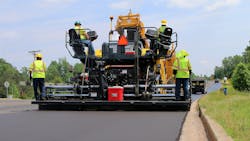How to Buy an Asphalt Paver
As IIJA money is circulating, more and more paving jobs are becoming available, and the asphalt paver market is benefiting.
Existing road contractors, states, and municipalities will soon be hard at work for another season, and other contractors may be considering entry into the market. One of the biggest decisions that must be made is purchasing the first paver.
Whether buying a new or used asphalt paver, total cost of ownership is a key factor. The longer the paver lasts—and the less it costs in downtime or maintenance—the faster it will earn back its initial investment and continue to make money.
Key considerations for pavers
Astec (Roadtec) dealer Tracey Road Equipment, based in upstate New York, has some pointers on buying pavers, starting with size, then focusing on performance, quality, propulsion, and mobility.
Read also: The top highway class asphalt pavers
1) Match size to project.
Make sure to choose the right size asphalt paver to maximize productivity with the lowest operating cost.
Tracey advises to consider the overall job size and configuration, and what type of materials that will be placed. Will it be cement-and-lime-stabilized sub-base, graded aggregate or bituminous, binder, or surface-course base?
Also pay attention to the width of the job and the desired paver speed.
2) Choose the right screed.
Compact asphalt pavers usually have an 8-foot screed, good for parking lots and narrow areas such as driveways or shoulders. They typically run from 3 to 20 horsepower and are rated between 100 and 400 tph (tons per hour, the number that helps define production).
Screeds are usually front mounted on smaller units, to increase handling and control. If the unit isn’t self-propelled, it can be towed behind a tractor or dump truck.
Larger, highway-class asphalt pavers incorporate a tractor that drives, steers, and distributes the asphalt and tows the screed, which shapes and levels material for the rollers that will follow. The pavers typically run 100 to 250 horsepower, with ratings from 300 to 750 tph. Screeds can go anywhere from 10 to 40 feet wide.
3) Mat quality.
Tracey says features that ensure top performance and mat quality are a must.
First, look for a heating and mixing system that ensures proper blend and temperature. The feeder system should provide efficient material distribution with minimal segregation and handwork.
For versatility, consider variable screed width, with a choice of front or rear extender. See if there are options available for the auger and conveyor systems and automatic conveyor tensioning.
There is plenty of diagnostic information available in today’s machines. Choose a model with self-diagnostics for more efficient maintenance.
Read also: How to Keep Asphalt Paving Safe
4) Also consider:
- Safety features such as a ventilation system that extracts fumes from the conveyor tunnel and auger chamber, directing them away from the operator.
- Operator comfort and convenience details that increase productivity, such as moveable, comfortable seats with good views, and easy-to-reach (and read) controls and monitors.
- A warranty, whether the paver is new or used.
- Support from the dealership.
OEMs have plenty of advice for buyers, particularly in the areas of size and technology.
“Cat asphalt pavers are available in various sizes to accommodate your specific applications,” says Nate Just, marketing manager for Cat Paving Products.
“For example, a smaller paver that requires towing has an average engine horsepower between 3 and 20, while a larger, self-propelled engine is between the 100- and 250-horsepower range,” Just says. “Large asphalt pavers are about 19 to 23 feet long, 10 feet wide, and 10 feet high and weigh between 20,000 to 40,000 pounds depending on the engine size, hopper capacity, drive system, and other components.
Tracks or tires?
- Smaller track pavers are good for confined areas because they can turn within their own footprint. Tracks are usually made of rubber because rubber moves faster than steel. Rubber provides the greatest flotation, particularly important if there’s a soft sub-base where wheels might sink. Better flotation also ensures greater stability and makes it easier to achieve a uniform surface.
- Tracks have better traction on steep terrain. Note that since they have more moving parts, maintenance and operating costs are higher. The complex undercarriage can increase initial price, and tracks can be costly to replace.
- Tires are good for jobs that don’t require so much traction or flotation, such as overlaying on an existing surface. They cost less, have lower maintenance and operating costs, and they’re faster to drive between jobs.
“Although a standard paving width is between 8 and 12 feet, a maximum width can reach up to 40 feet wide if you use screed extensions for your biggest projects,” Just says.
“If you’re working on wider job sites, pavers of more than 10 feet can support highway applications and larger projects like parking lots,” Just says. “The max thickness of asphalt paving in one pass ranges between 8 and 12 feet.”
Technology for asphalt pavers
Dr. Stephan Weller, software products manager at Vögele AG of the Wirtgen Group, says digital technology is an important component of the asphalt paver decision, particularly if a contractor is going to build a business around asphalt road building.
“Digital process optimization solutions significantly increase quality and efficiency in road construction but are frequently complex; this is why Vögele has been offering a three-tier modular system with different functional scopes,” Weller says.
The three tools are designed for the requirements of different construction projects and users, and some of them can be combined or expanded. The RoadScan noncontacting measuring system enables users to monitor paving temperature across the whole paved area, the WITOS Paving Docu documentation tool records and analyses both machine and process data, and the WITOS Paving Plus high-end solution allows all paving processes to be planned and then optimized in real time.
The company has expanded the three solutions by adding numerous functions that increase ease of use.
An important component in this is the new Job Site Temp app. Users of WITOS Paving Docu and WITOS Paving Plus who also use the RoadScan temperature measuring system can connect to the paver by QR code and activate the application. The Job Site Temp app now gives others working on the job site, such as paving supervisors and roller operators, in addition to paver operators, access to all the relevant information.
Apart from viewing paving temperatures in real time, the foreman, for example, can see other data such as current pave speed, screed width, and paver position. In order to work out where a particular truck is unloading, he or she can also show positions of trucks including the associated delivery note information. Roller operators likewise have the facility to view their own position and distance from the paver and to define exclusion zones.
“The Job Site Temp app gives paving crews a comprehensive real-time overview of all temperature data,” Weller says. “This mobile solution with its clear icons and simple menu-based navigation is furthermore tailored exactly to the needs of users. After all, no one on a job site wants to be held up by functions which require explanation.”
The app and the paver are networked via Wi-Fi, with the result that information can be exchanged between the RoadScan temperature measuring system and the smartphone even where there is no mobile phone connection. To achieve this, the paver sets up a Wi-Fi network with a radius of around 50 to 80 meters that acts as a server.
Vögele has also continued improving the temperature measuring system itself. RoadScan’s infrared camera measures paving temperatures across the whole area behind the screed in a width up to 10 meters.
To avoid faults in the thermal image due to moving objects, Vögele has developed automatic correction. The RoadScan system compares up to four images for a position, enabling it to detect moving obstacles such as those caused by scanning moving rollers, for example. These faulty measurements are removed from the thermal image at once, giving construction managers and paving supervisors a true-to-life overview of paving temperatures.
Vögele has furthermore optimized odometer calibration: RoadScan’s GPS receiver and the odometer are now calibrated automatically every 2 meters. “This prevents errors and saves additional effort,” Wellers says. “As a result, operator and paving supervisor are able to concentrate even better on the paving process itself.”
The WITOS Paving Docu documentation tool, too, has new practical features that users can exploit to monitor paving data and progress even better: Paving crews have the option of entering target project values such as target tonnages, paving sections, or areas directly in the Job Site app and of tracking progress. They can also have displayed in the relevant truck history delivery notes from trucks that have already unloaded.
Vögele has expanded the WITOS Paving Plus process optimization solution to make it easier for planners and construction managers to issue calls to tender. Once the relevant planning data has been entered in the control module, they can create a template for a paving and logistics concept and have it output in the form of a document which can be edited.
This saves time and effort, yet still gives the individual responsible the option of adding his or her own information or comments.
“All the new features and developments linked to our digital road construction solutions ultimately have the same objective: We want to make life easier for planners, construction managers, and paving crews and to give them the best possible support by providing reliable, straightforward, and transparent information,” Weller says.
About the Author
Frank Raczon
Raczon’s writing career spans nearly 25 years, including magazine publishing and public relations work with some of the industry’s major equipment manufacturers. He has won numerous awards in his career, including nods from the Construction Writers Association, the Association of Equipment Manufacturers, and BtoB magazine. He is responsible for the magazine's Buying Files.



